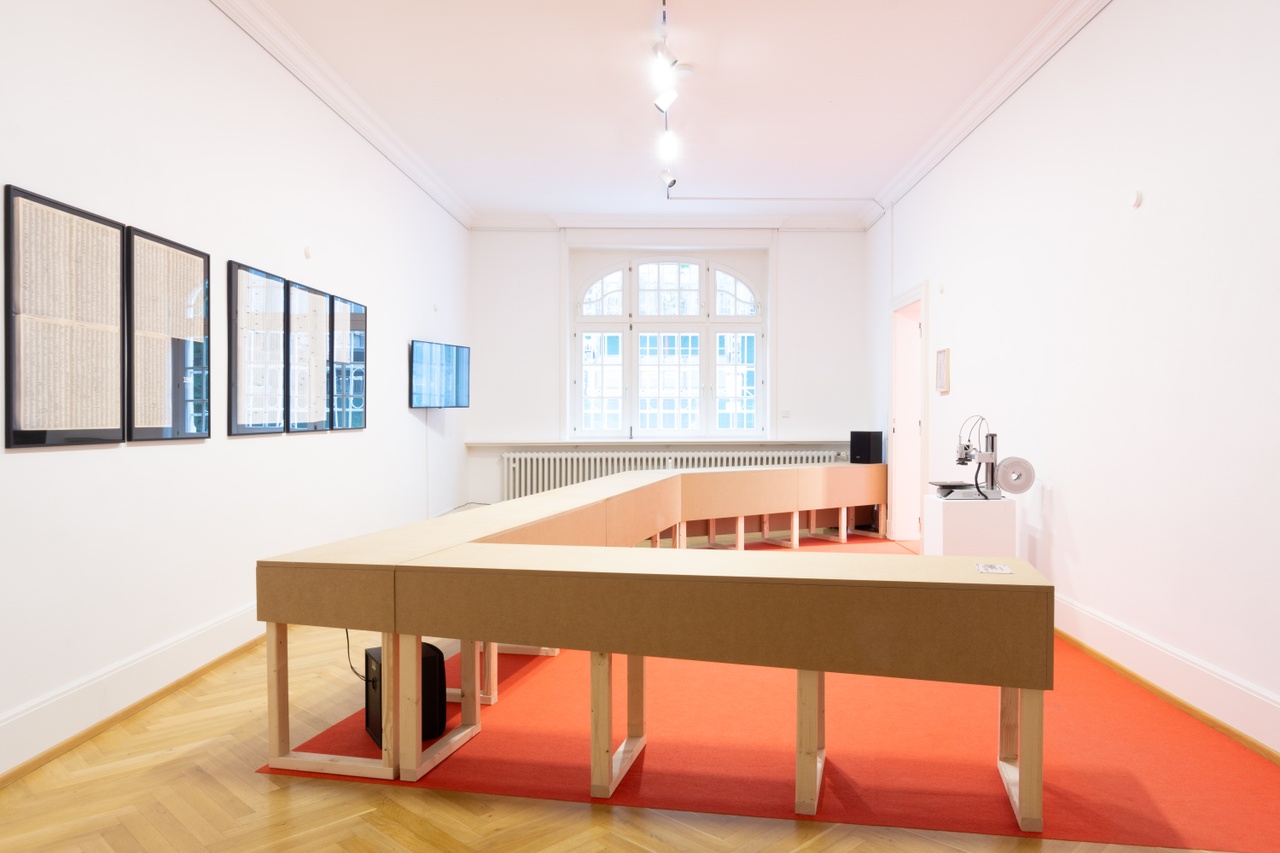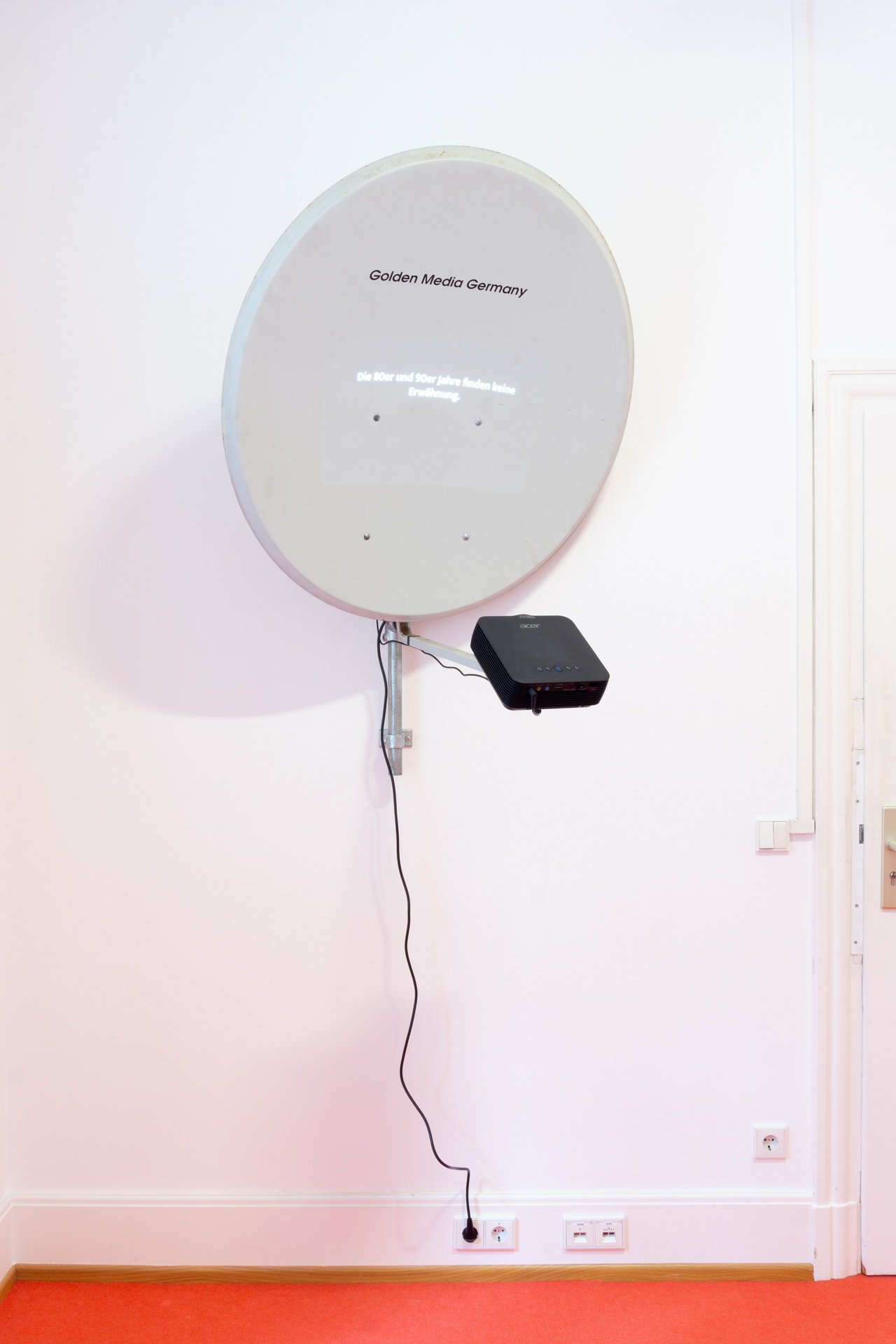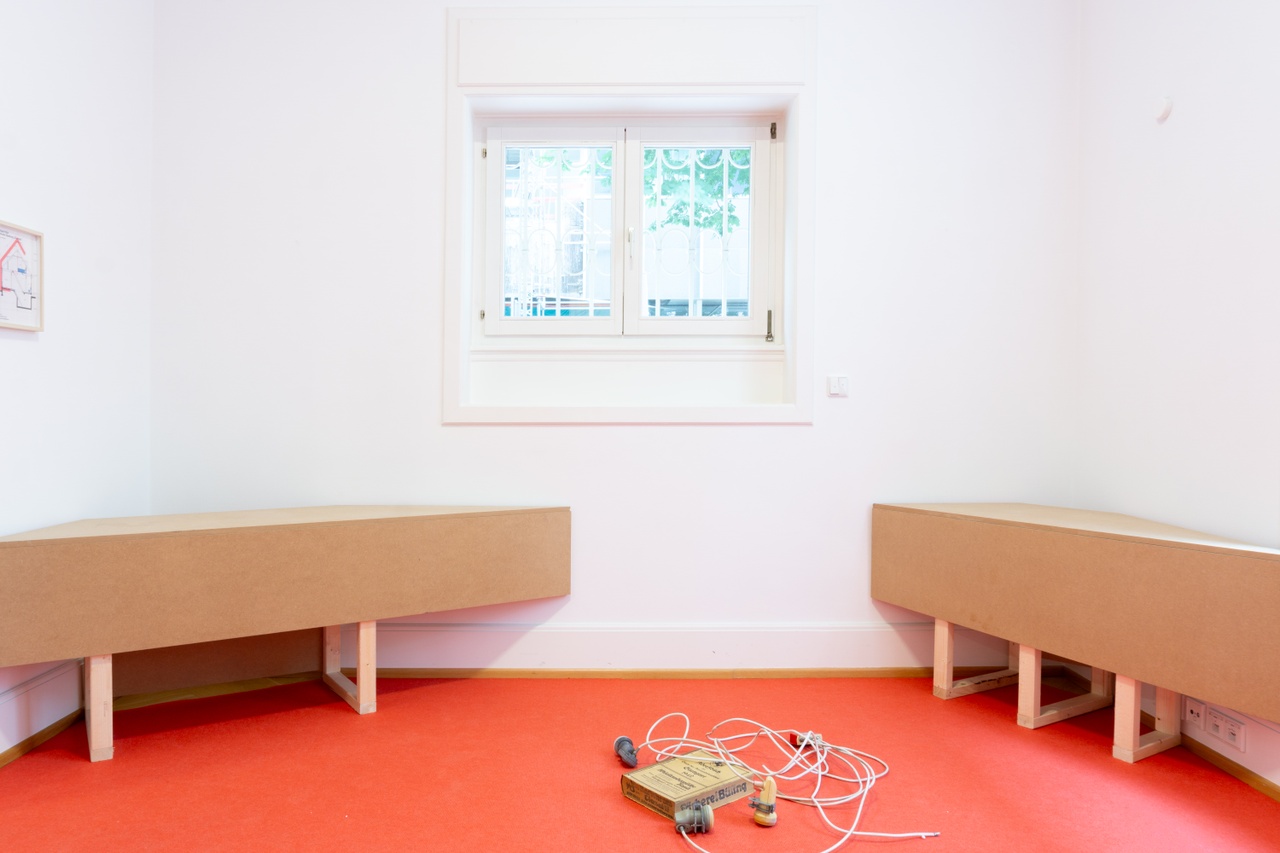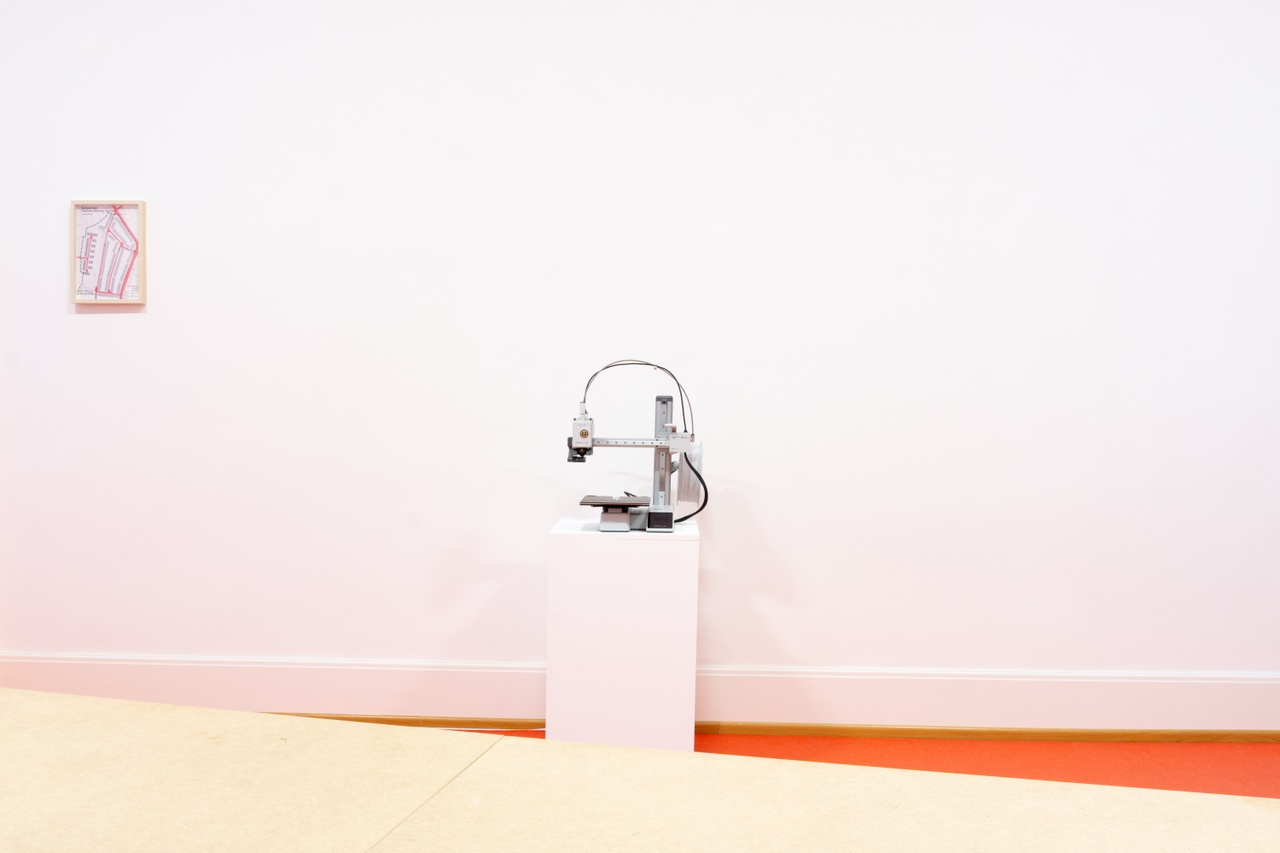FUGITIVE TRACES AND THE POLITICS OF ABSENCE Sarie Nijboer on Anike Joyce Sadiq at Sakhile&Me, Frankfurt am Main

“Anike Joyce Sadiq: Die fehlende Folge (‘The Missing Episode’),” Sakhile&Me, Frankfurt am Main, 2025
As you approach the gallery space, you are immediately confronted by an absence: A rectangular outline marked in black-and-white tape on the floor indicates that something is missing or has yet to arrive. The exhibition text reveals that the outline corresponds to the dimensions of Kreatur, a 1980 sculpture by artist Hüseyin Altin, around which “Die fehlende Folge (‘The Missing Episode’)” by Anike Joyce Sadiq at Sakhile&Me in Frankfurt am Main is framed. Kreatur was commissioned by the city of Stuttgart and installed at the center of the social housing estate Eiernest in the early 1980s, when many working-class migrant families were moving in, including Sadiq’s when she was three years old. It was precisely this demographic shift that a 2021 documentary on the history of Eiernest by regional broadcaster Südwestrundfunk (SWR) conspicuously skipped. This omission provided a starting point for Sadiq to explore the questions around memory, erasure, and resistance that eventually turned into the exhibition “Die fehlende Folge.”
Eiernest was originally developed in the early 1920s as part of Stuttgart’s social housing program, designed for municipal workers and their families. Though initially conceived as a temporary solution – intended to be torn down after just ten years – it remained in use and underwent several transformations throughout the 20th century. At the end of the century, it had become home to a growing number of migrant families, reflective of broader demographic shifts in Germany’s urban peripheries. A crucial turning point came in the early 2000s, when nationwide privatization policies reshaped public housing. In 1987, ownership of the site passed to the municipal housing company SWSG, which later initiated the gradual sale of the 176 heritage-listed houses to private owners. Sales occurred only when tenants voluntarily moved out, with existing tenants or their relatives holding the right of first refusal. After a ten-year holding period, buyers were allowed to resell their homes under market conditions. By 2010, approximately half of the estate had been transferred to buyers with no prior familial connection to Eiernest. The lapse of initial eligibility criteria for renters – such as savings, household income, and number of children – further increased the real estate value of these units. This completed the transition from collective, welfare-based housing toward individualized ownership and market-driven allocation.

“Anike Joyce Sadiq: Die fehlende Folge (‘The Missing Episode’),” Sakhile&Me, Frankfurt am Main, 2025
“Die fehlende Folge” is situated within this broader historical and political context, shaped by the gradual erosion of social infrastructure. For the exhibition, Sadiq returned to Eiernest as a place of personal memory, but also as a contested political site shaped by broader processes of migration, class restructuring, and institutional omissions.
Fragments of this layered history are reassembled through materials from public records inside the gallery space. In the first room, a 1942 Stuttgart address book lies on the floor. Its title, Adressbuch der Stadt der Auslandsdeutschen (Address book of the city of Germans abroad), appears misleading at first. While Ausländer means “foreigners,” Auslandsdeutsche refers specifically to Germans living abroad who have retained their citizenship. Yet, this book does not contain the addresses of Auslandsdeutsche: only Stuttgart addresses are listed. Stadt der Auslandsdeutschen was in fact the honorary title granted to Stuttgart by the Nazi regime because it was home to the Deutsches Ausland-Institut (now ifa – Institut für Auslandsbeziehungen), which coordinated Nazi diaspora policy. The phrase reflected the city’s institutional role in exporting a nationalist vision of Germanness beyond its borders. In a 1934 speech, Stuttgart’s Nazi mayor Karl Strölin invoked the phrase “Swabians all over the world,” praising their “tenacious and stubborn” refusal to assimilate as evidence of their firm attachment to their language and cultural identity.
Beyond its title, the address book also exposes a racialized classification system: It categorizes addresses into Jewish and non-Jewish households, implementing a policy of racial separation and exclusion in the bureaucratic logic of the Holocaust. By placing the book in the exhibition space, Sadiq highlights its dual function, as a tool for administrative propaganda and as an instrument of racial governance.
Besides the address book, old radio cables reference a little-known act of resistance against the Nazi regime (though mentioned in the SWR documentary): In February 1933, one of the tenants of the Eiernest housing estate participated in the so-called Kabelattentat (cable attack) on Adolf Hitler, aiming to sabotage a radio broadcast of his speech taking place in Stuttgart. At the time, the Eiernest, also known as the Rotes Eiernest (Red Eiernest), was a predominantly working-class area associated with leftist politics. Today, a Stolperstein in Eiernest memorializes this political defiance.
On an adjacent gallery wall, a satellite dish serves as a projection surface for a constellation of archival photos and text fragments. Among the materials is behind-the-scenes footage from a 1994 episode of Polizeiruf 110, a GDR crime series that continued after reunification under West German broadcasting institutions and was eventually absorbed into SWR. This particular episode was filmed on-site at Eiernest. Projected onto the satellite dish, the photos are juxtaposed with the artist’s typed notes commenting on media portrayals of Eiernest – including the 2021 documentary and Polizeiruf 110 itself. For instance, Sadiq’s words underscore the absence of the 1980s and 1990s in the documentary and how Polizeiruf 110 relied on visual clichés and stereotypes, such as trash bins on the streets and satellite dishes placed on façades to visualize migrant populations, poverty, and urban precarity. The satellite dish thus functions both as a literal projection surface and as a symbolic device: It frames Sadiq’s critical engagement with media narratives while highlighting the tropes through which social difference was rendered visible in public television.

“Anike Joyce Sadiq: Die fehlende Folge (‘The Missing Episode’),” Sakhile&Me, Frankfurt am Main, 2025
A short excerpt from the Polizeiruf 110 episode plays on a monitor in the second gallery room. To its left, Sadiq has mounted enlarged reproductions of address book pages from Eiernest streets taken from three editions – those of 1953, 1995, and 2016. Some former residents’ names are circled in black marker by Sadiq, tracing the presence and subsequent disappearance of surnames historically associated with postwar migration to Germany, including those of Turkish, Southern European, and Eastern European origin. The 1953 edition, published when the city of Stuttgart still owned the properties, lists not only the city as owner and the names of inhabitants but also professions – Automechaniker, Kraftfahrer, Postassistent, Näherin – providing insight into the working-class composition of the area. By 1995, references to public ownership and occupational titles have disappeared. In the 2016 edition, German- and other Western-sounding names predominate.
By treating these address books as social records, Sadiq foregrounds how the built environment and its administrative representation reflect broader histories of displacement, privatization, and demographic change. As anthropologist Ann Laura Stoler, among others, insists, archives are not passive containers of memory but sites of governance. [1] They are structured not only by what they record but also by what they omit. Sadiq mobilizes this “politics of omission” embedded in the address book records, thereby inviting the viewer to read what remains unspoken.
This focus on historical documents is complemented by a spatial intervention that translates Eiernest’s architectural features into the gallery setting. A plywood bench spans across the two gallery rooms, modeling to scale the communal seating structure that surrounds Hüseyin Altin’s Kreatur sculpture in the Eiernest housing estate to this day. Here introduced into the exhibition space as a decontextualized form, the bench forms a spatial threshold, guiding bodily orientation. It is placed in a way that disrupts direct access to the address book pages and the monitor on the wall: Although it remains possible to walk around the bench, the arrangement introduces a physical distance that hinders viewing and creates a brief sense of distance or hesitation.

“Anike Joyce Sadiq: Die fehlende Folge (‘The Missing Episode’),” Sakhile&Me, Frankfurt am Main, 2025
Extending into both rooms, a red carpet anchors the spatial arrangement of the bench. Its color echoes two architectural drawings on the wall: one a technical diagram of a single Eiernest house, the other an aerial view of the entire estate. These minimal spatial gestures – the carpet, bench, and taped floor outline – act as visual and physical interruptions. They require the viewer to navigate between restriction and passage, what art historian and critic Claire Bishop might call “productive antagonisms” [2] : material and spatial frictions that resist seamless spectatorship. Sadiq’s intermedial vocabulary – including architecture, video, photographs, and archival material – stages absence as something to be read, walked across, or temporarily inhabited. The exhibition critiques how cultural memory is shaped by public institutions and media through mechanisms of selective visibility. It highlights the systemic forces that shape what, and who, becomes part of public history: forces that often appear neutral or inclusive but operate through exclusionary logics.
And Hüseyin Altin’s sculpture? It reappears throughout the show through references – a remade title plate, a 3D printer producing miniature replicas for visitors to take away, and a sound recording of a conversation between Sadiq and Altin, in which the work itself is never discussed. Sadiq positions Eiernest as a case study in the politics of remembrance: how the past is curated, who is authorized to speak and to whom, and what remains unspoken in official histories and cultural memory. In this context, Sadiq enacts what theorist Trinh T. Minh-ha has termed as “speaking nearby” [3] – a mode of address that speaks neither for nor about the subject directly but gestures toward it, maintaining proximity while opening a space for critical reflection.
“Anike Joyce Sadiq: Die fehlende Folge (‘The Missing Episode’),” Sakhile&Me, Frankfurt am Main, May 11–June 14, 2025.
Sarie Nijboer is a curator and art writer living in Berlin. Her practice engages critically with the role of (visual) language – how it functions, fails, and shapes institutional and societal structures – while engaging with broader sociopolitical themes, collective memory, and human and non-human agency. She holds an MA in Cultures of the Curatorial from the Academy of Visual Arts (HGB) Leipzig. Since 2023, she has been a curator at Villa Heike e.V. in Berlin, an art space dedicated to the technical image.
Image credits: © Anike Joyce Sadiq, photos Sakhile&Me
Notes
| [1] | Ann Laura Stoler, Along the Archival Grain: Epistemic Anxieties and Colonial Common Sense (Princeton: Princeton University Press, 2010). |
| [2] | Claire Bishop critiques the prevailing assumption that participatory and socially engaged art must always strive for consensus, clarity, or redemptive community. In Artificial Hells: Participatory Art and the Politics of Spectatorship (Verso, 2012), she argues that antagonism, discomfort, and aesthetic distance can serve as vital tools for political and ethical engagement. |
| [3] | Nancy N. Chen, " 'Speaking Nearby,' a Conversation with Trinh T. Minh-ha," Visual Anthropology Review 8, no. 1 (spring 1992), 82–91. |

